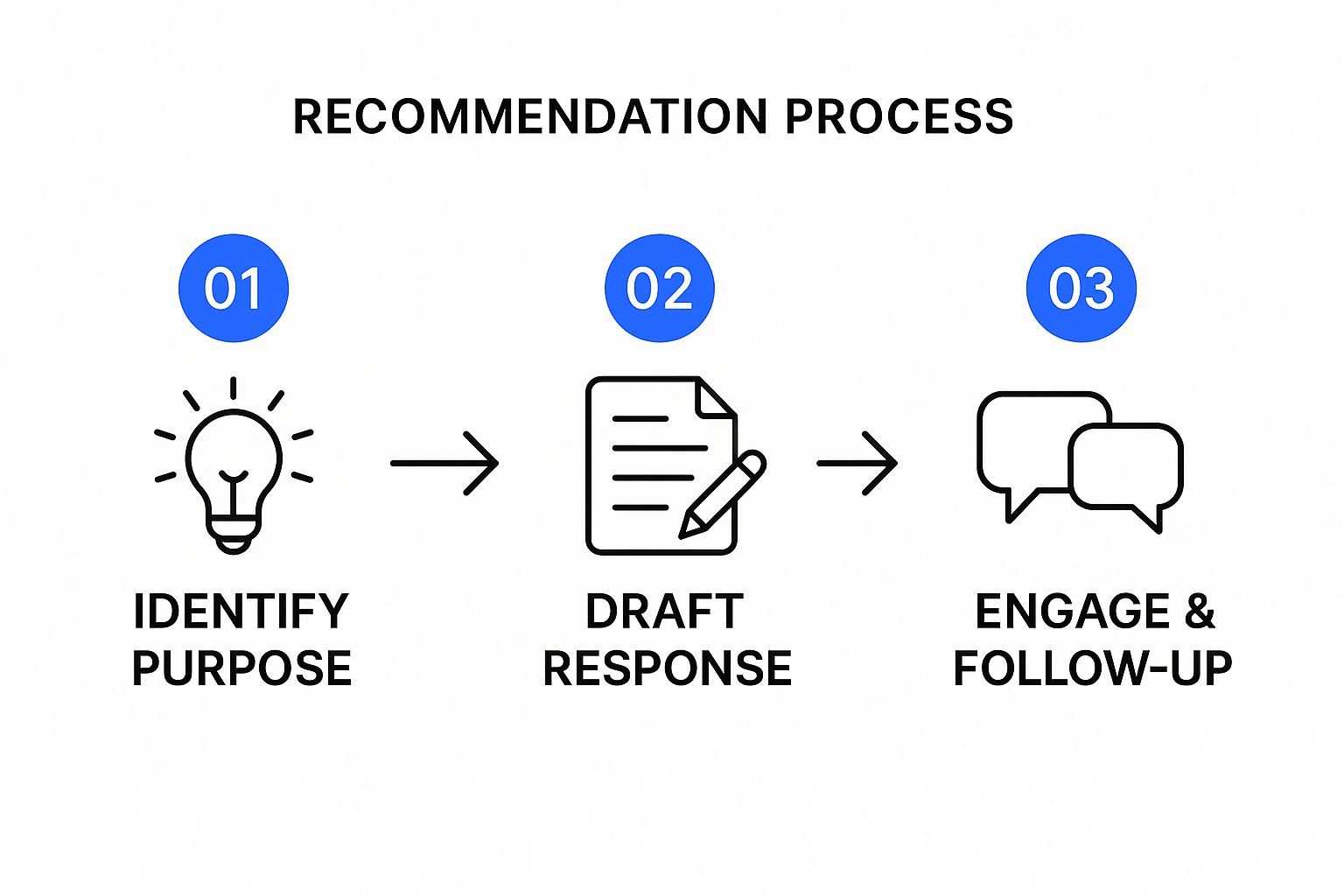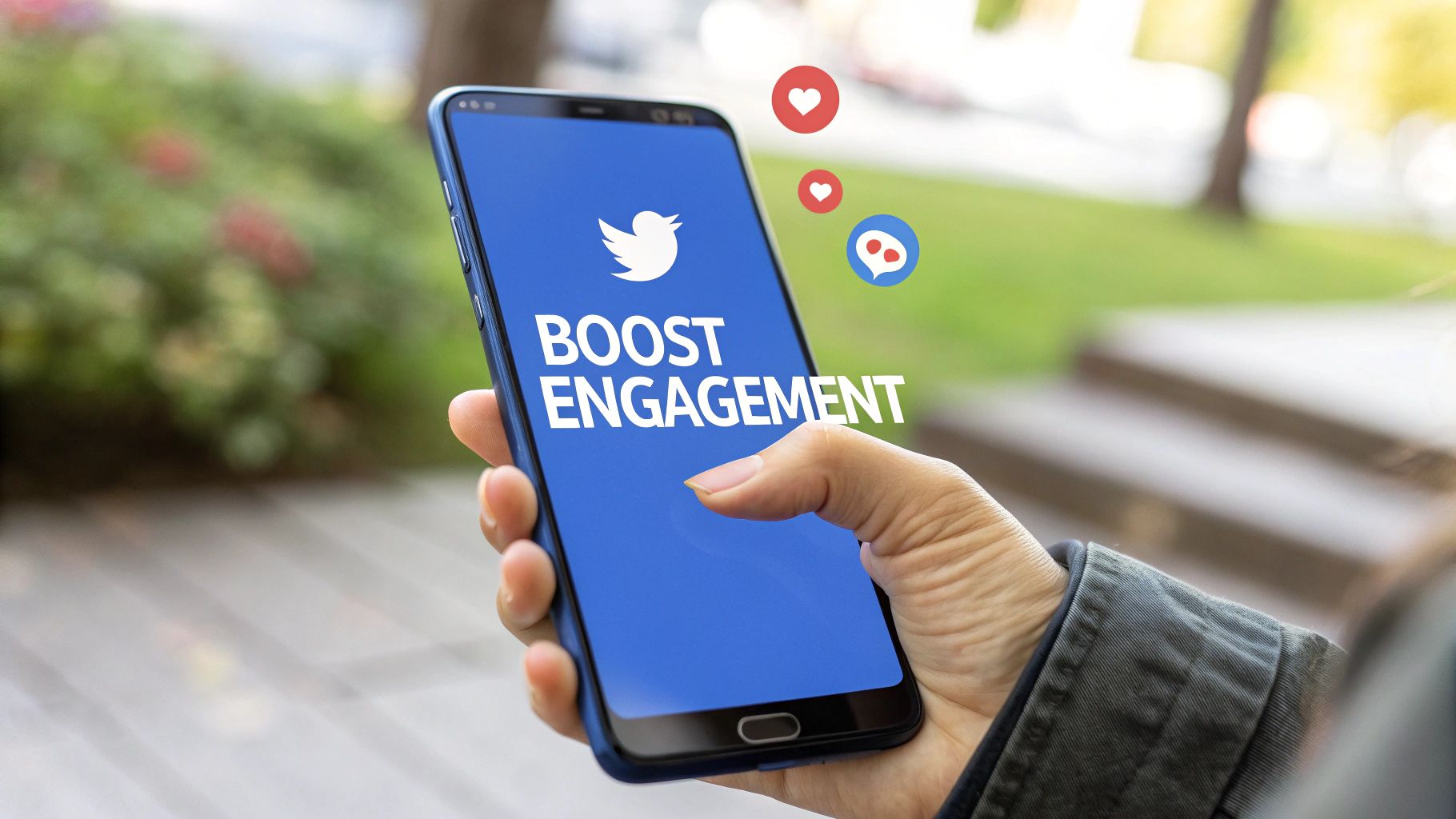Welcome to the playbook for mastering conversations on X. In a feed that never stops moving, knowing how to respond on Twitter is more than just good manners—it’s one of the most powerful growth hacks you have. A single, well-placed reply can often do more for your authority and follower count than a dozen original tweets.
Why Your Reply Game on X Matters More Than Ever

Most creators get stuck on a one-way track, focusing all their energy on broadcasting their own message. It's a classic mistake. The real magic, the kind that builds communities and sparks viral moments, happens in the trenches of existing conversations. This entire guide is built on a simple truth I've seen play out time and time again: a smart reply can get you more impressions, profile clicks, and followers than an original tweet that just fades away.
The dynamics of the platform have changed, making responsive engagement a non-negotiable part of any serious growth strategy.
Key Shifts in X User Behavior
| Metric | Change/Trend | Implication for Your Strategy |
|---|---|---|
| User Engagement | Increased replies per tweet; users crave direct conversation. | Shift focus from broadcasting to participating. Your voice in a discussion is valuable. |
| Brand Interaction | Branded content saw a 63% growth in likes late last year. | Users are rewarding brands that engage authentically. Don't be afraid to show up. |
| Content Discovery | The algorithm heavily favors engaging conversations, pushing them to more feeds. | A high-traction reply can get you seen by thousands of people outside your network. |
This data confirms what experienced users already know: X is no longer a megaphone, it's a massive, ongoing conversation. Jumping in is how you get noticed. You can dig deeper into these X platform trends to see what they mean for creators.
Your goal is to stop being a passive scroller and become an active participant. Think of your replies as your digital business card, showcasing your expertise and personality to everyone in the thread.
The 3 Pillars of a Perfect Reply
To make sure your replies consistently hit the mark, we're going to zero in on three core skills throughout this guide:
- Spotting the Right Moment: I'll show you how to find high-potential conversations before they blow up, giving you a massive first-mover advantage.
- Delivering Real Value: We'll move past generic comments like "great point!" and into crafting responses that add a fresh perspective, useful data, or a bit of wit.
- Mastering Your Timing: It’s not just what you say, but when you say it. Understanding the rhythm of a conversation is key to capturing attention.
Nail these three pillars, and you’ll turn your reply section into your single best tool for growth on X.
Find High-Momentum Tweets Before They Peak
The secret to a viral reply isn't just what you say, but when you say it. Jumping on a tweet that already has thousands of replies is a recipe for getting your comment lost in the noise. The real magic happens when you spot a conversation with massive potential before the crowd rushes in.
This isn't just about following the biggest names in your industry. It's about learning to read the subtle tea leaves of the X algorithm—the early signals that a tweet is about to catch fire. Once you know what to look for, you can't unsee them.
This simple, repeatable process turns those opportunities into real engagement.

The big takeaway here? Great engagement is intentional, not random. It starts with a clear goal and ends with genuine interaction.
Spotting Early Engagement Signals
Certain patterns scream "this is about to blow up." For instance, a high reply-to-like ratio is a classic indicator of a hot-button topic. If a tweet has 50 replies but only 30 likes, you've found a goldmine for discussion and debate.
Another huge tell is seeing early replies from several influential accounts. When you notice a handful of well-known people in your niche all jumping on the same tweet within its first hour, that’s a clear sign the algorithm is about to push it to the moon.
Pro Tip: Keep an eye out for "question" tweets from authority figures. When an expert asks their audience for opinions, experiences, or advice, the replies get a ton of visibility. Better yet, the original poster is far more likely to engage with thoughtful responses.
Building Your Opportunity Feed
Endlessly scrolling your timeline hoping to stumble upon these signals is a huge time sink. You need to build a custom feed that brings these opportunities directly to you.
Here's how I do it:
- Create Targeted X Lists: I have several private lists on X for creators, industry leaders, and even my competitors. This gives me a clean, focused timeline without all the algorithmic fluff, making it way easier to spot momentum building.
- Master Advanced Search: Get comfortable with X's advanced search. You can filter for tweets from specific accounts that have a minimum number of replies (like
min_replies:20) posted in the last few hours. It's a game-changer. - Use the Right Tools: A tool like Reply Guy is literally designed for this. It automatically sifts through your timeline to find posts with high momentum, flagging them based on metrics like views per minute. It saves me hours of manual work every single week.
For more hands-on advice, check out our guide on the 5 best practices for engaging with trending tweets. By systemizing how you find these posts, you guarantee you're one of the first voices in a conversation that's about to go big.
Craft Replies That Add Value and Get Noticed

A generic "great point!" is a missed shot. When you find a tweet that’s taking off, your reply is your moment to stand out from the noise. The secret isn't just knowing how to reply, but learning how to become an active, valuable part of the conversation instead of just another face in the crowd.
Your goal is to be remembered, not just seen. To do that, you have to move past simple agreement and actually contribute something that makes the discussion better. Attention is a finite resource on X, so your replies need to be sharp and to the point.
This has never been more true. With the overall engagement rate per post on X dropping, it's clear people are getting more selective about what they interact with. That means concise, value-packed replies are your best bet for getting noticed.
Four Frameworks for High-Impact Replies
Staring at a blank reply box is frustrating. Instead, try using a framework to organize your thoughts and deliver real value. Each of these gives you a different angle of attack.
- Drop a Data Point: Someone makes a solid point? Back it up with a hard number. Linking to a relevant study or dropping a key statistic adds weight to their argument and shows you know your stuff.
- Share a Personal Story: A quick, relevant anecdote makes an idea feel real. If an account tweets about a business challenge, sharing a short story about how you tackled something similar creates an instant human connection. It works wonders.
- Ask a Sharp Follow-Up Question: A genuinely curious question can take the conversation in a new, interesting direction and invites the original poster to expand on their thoughts. It shows you’re actually thinking, not just skimming.
- Use a Clever Visual: Sometimes, a well-placed GIF, a simple chart, or an infographic says more than words ever could. The right visual can be a serious pattern-interrupt for people scrolling their feed.
The best replies feel less like comments and more like contributions. They either add new information, offer a fresh perspective, or make the original point stronger.
Putting It Into Practice
Let's walk through a real-world example. Imagine a marketing influencer tweets: "Too many brands are obsessed with finding new customers instead of keeping the ones they've got."
A weak reply is the classic: "So true!" It adds nothing.
A much stronger reply, using one of our frameworks, would look like this: "Totally agree. It's wild that a 5% increase in customer retention can boost profitability by 25% to 95%. It's the most overlooked growth lever."
See the difference? This reply not only validates the original tweet but also enriches the conversation for everyone who sees it by adding a powerful, concrete statistic.
If you're looking to really master the art of crafting messages that stick, it's worth exploring the principles of how to speak so that people want to listen. You can also find more practical tips in our guide on the 7 proven ways to increase Twitter reply engagement.
Adapt Your Tone to Connect with Any Audience
https://www.youtube.com/embed/x_QmvZRS85U
A reply that lands perfectly in a serious tech discussion will likely fall flat in a community of artists. This is the art of "reading the room" on X, and it's a skill that separates the replies that get ignored from those that get amplified.
Before you even think about what to write, take a second to get a feel for the conversation. Is the original tweet a formal, data-heavy analysis? Or is it a lighthearted joke flying between friends? The tone of your reply should always try to match the energy of the thread you're jumping into. A mismatch is one of the fastest ways to look like you don't belong.
Reading the Digital Room
The way you reply matters just as much as what you say. In a serious B2B discussion, a thoughtful, well-reasoned text reply is almost always the best bet. But if you're jumping on a viral meme or a pop culture moment, the perfect GIF can say more—and get more engagement—than a paragraph of text ever could.
This kind of adaptability is more important than ever. While the U.S. remains X's biggest market, huge growth is happening in places like Japan, India, and Brazil. On top of that, younger users make up more than half of all vertical video viewers, showing a clear preference for different content formats. You can explore more key user statistics on Search Logistics to get a better sense of this diverse landscape.
Your online persona shouldn't be a monolith. Think of it as having different conversational gears. You can be the insightful professional in one thread and the witty, casual observer in the next, all while staying true to who you are.
Developing Authentic Response Personas
This isn't about being fake. It's about showing different sides of your personality or brand voice where they fit best. For instance, your "persona" for answering a technical question should probably be helpful and direct. But when you're replying to a customer's complaint, you'll want to switch to a more empathetic and solution-focused persona.
The key to mastering this is paying attention to what works. Over time, you'll get a feel for which tones and formats connect with certain audiences. This constant feedback loop ensures your replies always feel relevant and, ultimately, get you the engagement you're looking for. If you want to get granular with the data, our guide on how to see Twitter analytics is a great place to start tracking your performance.
Advanced Reply Tactics for Maximum Visibility

Alright, let's move past the basics. If you really want to blow up your reach, you need to think like a seasoned X user. It's not just about firing off a single great reply; it’s about strategically building on that initial interaction to draw in a much bigger crowd. This is where a few clever tactics can make all the difference.
One of my favorite, and most effective, techniques is the 'Reply Chain'. Instead of trying to squeeze every insight into one monster reply, post your main point first. Then, immediately reply to your own comment. This builds a small, self-contained thread right under the main tweet, letting you add more detail, data, or even a GIF without making your first reply look cluttered.
The X algorithm tends to boost early replies that get a lot of interaction. When you drop a valuable comment and follow it up with your own reply chain, you're signaling a high-quality conversation. This seriously increases your odds of getting that coveted top spot under the original tweet.
How to Amplify Your Reply Strategically
Knowing how to respond on X is really about getting the right eyeballs on your comment. You can use a few tricks to expand your audience without coming across as spammy. For instance, if you're adding a totally fresh take, use the "Quote" feature on the original tweet. This gives your own followers instant context and pulls them into the conversation.
And don't hesitate to tag another expert or creator if your reply genuinely adds to a point they've made elsewhere. A well-placed mention can bring another influential voice into the mix, and with them, their audience.
Here are a few more ways to layer your responses for more impact:
- Go Easy on Hashtags: If a hashtag is genuinely relevant and trending, adding it can give you a nice little visibility bump. But stick to just one or two, max. Anything more looks desperate.
- Time It Right: This is so important. Dropping your reply when your target audience is most active is key. Think about peak hours in major time zones to make sure people see your comment as it happens.
For a broader look at engagement that works everywhere, check out these proven tips to increase social media engagement. When you combine those general principles with the platform-specific advice in our guide, you'll be well on your way. You can read more here: https://www.getreplyguy.com/blog/twitter-growth-guide-strategic-replies-that-convert
Answering Your Top Questions About Twitter Replies
As you start using replies to grow your presence on X, you'll inevitably run into some common questions. I've been there. Getting these details right is what separates the pros from the people just shouting into the void. Let's clear up a few things I see trip people up all the time.
How Often Should I Actually Be Replying to People?
Forget about just hitting a random number. The real focus should be on quality over sheer quantity. If you're looking for a solid benchmark, aim for 5-10 thoughtful replies per day.
Honestly, a handful of insightful, well-crafted replies will do more for you than a hundred generic "great point!" comments. The goal is to become a recognized and valuable voice within your niche. It’s better to make a real impact on a few conversations than to leave zero impression on many. Check your profile visits from your replies to see what's actually working.
Should I Reply to Big Accounts or Smaller Ones?
This is a classic dilemma, and the best answer is: a mix of both.
Replying to a massive account with millions of followers can feel like a lottery. If you get noticed, the payoff in visibility is huge. But let's be real—the competition is insane, and your chances of standing out are slim.
On the other hand, engaging with smaller or mid-sized accounts in your field is where you build real community. The person who posted is far more likely to see your comment, respond, and even follow you. A balanced approach gives you the best of both worlds.
What's the Best Way to Handle Trolls and Negative Comments?
I live by one simple rule here: don't feed the trolls.
If a comment is just pure abuse or a bad-faith attack, your best move is a swift click of the mute or block button. Don't even think about engaging. It's a total waste of your time and energy, and it just drags down the conversation for everyone else.
Now, if it's genuine, constructive criticism, that's a different story. A calm, respectful public response can actually build trust and show you're confident in what you do. But sometimes, the most powerful response is no response at all. You can learn more about how to improve Twitter engagement and boost your reach in 2025 in our full guide.
Ready to stop guessing and start growing? Reply Guy is a Chrome extension that finds high-momentum tweets for you, so you can focus on writing replies that get seen. Save hours of scrolling and transform your engagement by visiting https://www.getreplyguy.com.
